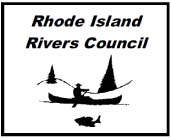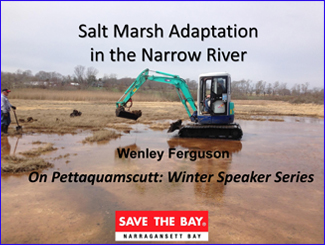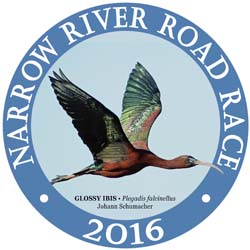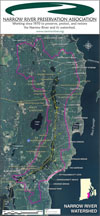|
Pilot Program at Middlebridge Tests Methods for Enhancing Marsh Resiliency
On March 23, the R.I. Coastal Resources Management Council and U.S. Fish & Wildlife Service began a marsh restoration pilot study on the marsh just south of Middlebridge. The pilot is comparing two methods of “thin-layer deposition” in which a layer of sand is used to raise the elevation of the marsh surface and thus enable the marsh to keep up with sea level rise.
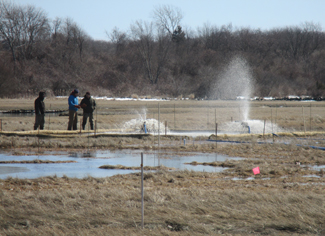
The pilot will compare the results of two 50 by 100 foot plots where roughly four inches (100 cubic yards) of sand were added.
With the hydraulic method used for the first plot, water, air and sand were combined in a tank and pumped onto the marsh.
In the second plot, the layer of sand was spread using a Bobcat loader.
USFWS scientists will be measuring sediment levels, vegetation response and peat compression (soil bulk density) throughout the year to help inform suggested methods for larger scale thin-layer deposition of material dredged from Narrow River later this year.
The work is part of a multi-prong USFWS effort to restore estuarine conditions in the John H. Chafee National Wildlife Refuge in the Narrow River to enhance resiliency against sea level rise, climate change and future storm events.
See more pictures of the pilot study at Middlebridge.
|
On Pettaquamscutt Series Wraps up with Talk on Marsh Adaptation
For the third and final presentation of the 2015 On Pettaquamscutt winter speaker series, Wenley Ferguson of Save the Bay and Nick Ernst of USFWS explained the various strategies for marsh adaptation being used in Narrow River and throughout the Narragansett Bay Estuary.
Click the title slide below to see Wenley's presentation.
Click the title slide below to see Nick's presentation.
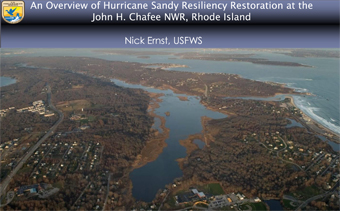
Some of the tools in the Narrow River strategy include:
- Dredging in selected locations to improve channel flow and promote eel grass growth
- Marsh edge protection using coir logs and bagged oyster shells (a method also being evaluated near Middlebridge)
- Digging runnels and repairing existing ones to improve surface drainage.
|

